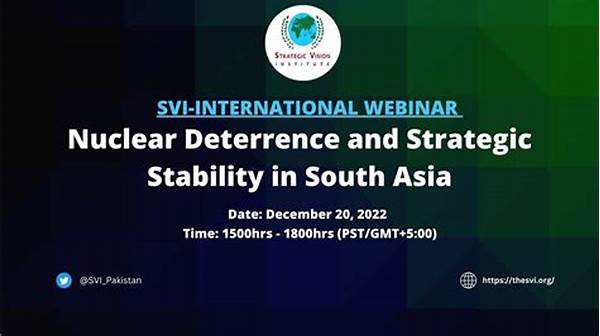The Concept of Strategic Stability
Strategic stability through nuclear deterrence represents a pivotal doctrine in international security policy, aimed at maintaining global balance by discouraging nuclear aggression. The premise is that when two or more states possess significant nuclear capabilities, the prospect of mutual assured destruction serves as a deterrent against their use. This principle has long been the cornerstone of nuclear policy, especially during the Cold War era, where the United States and the Soviet Union maintained equilibrium through a balance of terror.
The effectiveness of strategic stability through nuclear deterrence hinges on credible retaliatory capabilities. Nations must ensure their second-strike capabilities are robust enough to survive an initial attack and respond effectively. This assurance acts as a powerfully stabilizing factor, discouraging adversaries from initiating conflict. In this sense, nuclear deterrence functions as both a shield and a sword, poised to retaliate yet primarily serving as an instrument of peace.
However, strategic stability through nuclear deterrence is not without its challenges. Modern-day advancements in technology and shifts in geopolitical landscapes necessitate continuous reevaluation of deterrent strategies. The emergence of cyber warfare, missile defense systems, and the proliferation of nuclear weapons amongst smaller states introduce complexities that could potentially undermine traditional deterrence models. Thus, ongoing diplomatic engagement, arms control agreements, and confidence-building measures remain integral to sustaining global stability.
Historical Context of Nuclear Deterrence
During the Cold War, strategic stability through nuclear deterrence played a critical role in maintaining peace between superpowers. This era witnessed the development of extensive nuclear arsenals by both the United States and the Soviet Union, establishing a tense yet stable equilibrium.
In the post-Cold War era, strategic stability through nuclear deterrence continues to influence global politics. Nations with nuclear capabilities engage in diplomatic negotiations to ensure the effectiveness and survivability of their deterrents, preventing potential nuclear escalation.
Regional conflicts pose a challenge to strategic stability through nuclear deterrence. Tensions between nuclear-armed states necessitate diplomatic diligence to avoid conflicts that could disrupt the fragile balance maintained by deterrence dynamics.
Technological advancements constantly affect strategic stability through nuclear deterrence. Innovations such as missile defense systems and cyber warfare require states to adapt their deterrent strategies to maintain effectiveness in ensuring global stability.
Strategic stability through nuclear deterrence requires international cooperation and dialogue. Multilateral treaties and agreements serve as mechanisms to reduce the risks associated with nuclear proliferation and reinforce global security frameworks.
Challenges to Strategic Stability
The intricate nature of strategic stability through nuclear deterrence presents multifaceted challenges. One prominent issue is the proliferation of nuclear capabilities among states with varying degrees of technological sophistication. As more countries seek to establish nuclear arsenals, the potential for instability increases. The delicate balance maintained by traditional superpowers may be disrupted, creating a need for reevaluation and adaptation of deterrence strategies. Furthermore, the global security landscape is increasingly influenced by non-state actors and rogue regimes, whose unpredictable behavior can undermine strategic stability.
Another challenge stems from technological advancements that could render existing nuclear arsenals vulnerable. The development of missile defense systems and cyber warfare capabilities threatens to diminish the effectiveness of deterrence by potentially neutralizing a state’s retaliatory capabilities. Consequently, nations must invest in modernizing their arsenals and strengthening their deterrent resolve to maintain strategic stability.
Additionally, geopolitical tensions and regional disputes exacerbate the delicate balance inherent in strategic stability through nuclear deterrence. Rivalries between nuclear-armed states can escalate rapidly, necessitating adept diplomatic engagement and conflict prevention mechanisms. Efforts to promote multilateral arms control agreements and confidence-building measures are essential to mitigating these risks and preserving global peace.
The Impact of Modern Technologies
Strategic stability through nuclear deterrence is heavily influenced by advancements in modern technologies. The emergence of cyber warfare poses a significant risk to nuclear command and control systems, potentially compromising the integrity and reliability of deterrence strategies.
Technological developments in missile defense systems challenge traditional deterrence models. These systems can intercept nuclear warheads, potentially undermining second-strike capabilities and destabilizing the established balance among nuclear-armed states.
Non-traditional technologies, such as hypersonic weapons, further complicate strategic stability through nuclear deterrence. Their rapid speed and maneuverability present difficulties in tracking and interception, necessitating the adaptation of existing deterrence frameworks to address their implications.
The integration of artificial intelligence into military technologies also has implications for strategic stability through nuclear deterrence. AI-driven decision-making processes could introduce new risks, prompting concerns over unintended escalations due to machine errors or misinterpretations.
Efforts to maintain strategic stability through nuclear deterrence must account for the global proliferation of dual-use technologies. Balancing civilian and military applications requires comprehensive regulatory frameworks and international cooperation to ensure that technological advancements do not destabilize global security.
Diplomatic Efforts and Arms Control
The pursuit of strategic stability through nuclear deterrence necessitates robust diplomatic efforts and comprehensive arms control agreements. International dialogues, such as the Treaty on the Non-Proliferation of Nuclear Weapons (NPT), play a critical role in preventing the proliferation of nuclear arms and ensuring global security.
Diplomatic negotiations aimed at reducing nuclear arsenals and curbing the development of new weapons are vital to maintaining strategic stability through nuclear deterrence. Bilateral and multilateral treaties foster confidence among states and contribute to a transparent security environment that reduces the risk of nuclear escalation.
Strategic stability through nuclear deterrence benefits from the establishment of verification and compliance mechanisms. Monitoring systems and inspection protocols enhance trust between states, ensuring adherence to arms control commitments and reinforcing the credibility of deterrence strategies.
Crisis management and communication channels between nuclear-armed states are indispensable components of strategic stability through nuclear deterrence. These mechanisms provide a means to deescalate tensions and prevent miscalculations that could lead to armed conflict.
In the era of technological advancements, adapting existing arms control frameworks to address emerging threats is crucial. Proactive diplomatic engagement is necessary to develop new agreements and regulations that encompass contemporary challenges, ensuring strategic stability through nuclear deterrence in a rapidly evolving security landscape.
Regional Dynamics and Alliances
Strategic stability through nuclear deterrence is profoundly influenced by regional dynamics and alliances. Geopolitical tensions between neighboring states with nuclear arsenals necessitate careful diplomatic navigation to prevent conflicts that could disrupt the established equilibrium.
Alliances play a pivotal role in maintaining strategic stability through nuclear deterrence. Collective defense agreements, such as NATO, provide reassurance among member states and enhance deterrence capabilities. These alliances also serve as platforms for diplomatic engagement, promoting dialogue and conflict resolution.
The presence of nuclear-armed states within regions of geopolitical instability poses unique challenges to strategic stability through nuclear deterrence. Diplomatic initiatives and confidence-building measures are essential in mitigating potential flashpoints and avoiding nuclear escalation.
Regional deterrence strategies require a tailored approach that considers the specific security concerns of individual states. Ensuring strategic stability through nuclear deterrence involves addressing asymmetric threats and balancing power dynamics within each region.
Cooperative security frameworks, such as regional security organizations, contribute to strategic stability through nuclear deterrence. By fostering collaboration and dialogue, these frameworks help build trust among states and prevent potential conflicts through peaceful means.
Conclusion
In conclusion, strategic stability through nuclear deterrence remains an essential component of global security frameworks. The doctrine serves as a fundamental deterrent against nuclear aggression, maintaining a balance of power that discourages the use of nuclear weapons through the threat of mutual assured destruction. However, the evolving security landscape, influenced by technological advancements and geopolitical shifts, presents both challenges and opportunities for enhancing this stability.
Diplomatic efforts, arms control agreements, and regional cooperation play critical roles in preserving strategic stability through nuclear deterrence. States must address emerging threats, such as cyber warfare and missile defense systems, to ensure the continued effectiveness of deterrence strategies. The pursuit of international dialogue and comprehensive verification mechanisms enhances trust between nations, reinforcing the credibility of deterrence and preventing potential nuclear escalations.
Ultimately, the success of strategic stability through nuclear deterrence relies on the collective commitment of the international community to uphold peace and security. Through adaptive strategies, sustained diplomatic engagement, and a commitment to arms control, nations can navigate the complexities of modern security challenges while safeguarding global stability for future generations.





